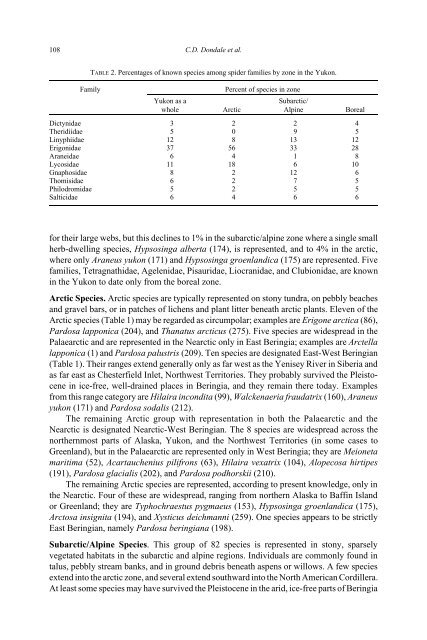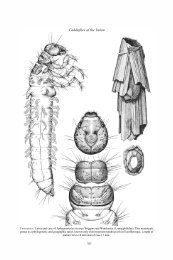Spiders of the Yukon - Department of Biological Sciences
Spiders of the Yukon - Department of Biological Sciences
Spiders of the Yukon - Department of Biological Sciences
You also want an ePaper? Increase the reach of your titles
YUMPU automatically turns print PDFs into web optimized ePapers that Google loves.
108 C.D. Dondale et al.<br />
TABLE 2. Percentages <strong>of</strong> known species among spider families by zone in <strong>the</strong> <strong>Yukon</strong>.<br />
Family Percent <strong>of</strong> species in zone<br />
<strong>Yukon</strong> as a<br />
whole Arctic<br />
Subarctic/<br />
Alpine Boreal<br />
Dictynidae 3 2 2 4<br />
Theridiidae 5 0 9 5<br />
Linyphiidae 12 8 13 12<br />
Erigonidae 37 56 33 28<br />
Araneidae 6 4 1 8<br />
Lycosidae 11 18 6 10<br />
Gnaphosidae 8 2 12 6<br />
Thomisidae 6 2 7 5<br />
Philodromidae 5 2 5 5<br />
Salticidae 6 4 6 6<br />
for <strong>the</strong>ir large webs, but this declines to 1% in <strong>the</strong> subarctic/alpine zone where a single small<br />
herb-dwelling species, Hypsosinga alberta (174), is represented, and to 4% in <strong>the</strong> arctic,<br />
where only Araneus yukon (171) and Hypsosinga groenlandica (175) are represented. Five<br />
families, Tetragnathidae, Agelenidae, Pisauridae, Liocranidae, and Clubionidae, are known<br />
in <strong>the</strong> <strong>Yukon</strong> to date only from <strong>the</strong> boreal zone.<br />
Arctic Species. Arctic species are typically represented on stony tundra, on pebbly beaches<br />
and gravel bars, or in patches <strong>of</strong> lichens and plant litter beneath arctic plants. Eleven <strong>of</strong> <strong>the</strong><br />
Arctic species (Table 1) may be regarded as circumpolar; examples are Erigone arctica (86),<br />
Pardosa lapponica (204), and Thanatus arcticus (275). Five species are widespread in <strong>the</strong><br />
Palaearctic and are represented in <strong>the</strong> Nearctic only in East Beringia; examples are Arctella<br />
lapponica (1) and Pardosa palustris (209). Ten species are designated East-West Beringian<br />
(Table 1). Their ranges extend generally only as far west as <strong>the</strong> Yenisey River in Siberia and<br />
as far east as Chesterfield Inlet, Northwest Territories. They probably survived <strong>the</strong> Pleistocene<br />
in ice-free, well-drained places in Beringia, and <strong>the</strong>y remain <strong>the</strong>re today. Examples<br />
from this range category are Hilaira incondita (99), Walckenaeria fraudatrix (160), Araneus<br />
yukon (171) and Pardosa sodalis (212).<br />
The remaining Arctic group with representation in both <strong>the</strong> Palaearctic and <strong>the</strong><br />
Nearctic is designated Nearctic-West Beringian. The 8 species are widespread across <strong>the</strong><br />
nor<strong>the</strong>rnmost parts <strong>of</strong> Alaska, <strong>Yukon</strong>, and <strong>the</strong> Northwest Territories (in some cases to<br />
Greenland), but in <strong>the</strong> Palaearctic are represented only in West Beringia; <strong>the</strong>y are Meioneta<br />
maritima (52), Acartauchenius pilifrons (63), Hilaira vexatrix (104), Alopecosa hirtipes<br />
(191), Pardosa glacialis (202), and Pardosa podhorskii (210).<br />
The remaining Arctic species are represented, according to present knowledge, only in<br />
<strong>the</strong> Nearctic. Four <strong>of</strong> <strong>the</strong>se are widespread, ranging from nor<strong>the</strong>rn Alaska to Baffin Island<br />
or Greenland; <strong>the</strong>y are Typhochraestus pygmaeus (153), Hypsosinga groenlandica (175),<br />
Arctosa insignita (194), and Xysticus deichmanni (259). One species appears to be strictly<br />
East Beringian, namely Pardosa beringiana (198).<br />
Subarctic/Alpine Species. This group <strong>of</strong> 82 species is represented in stony, sparsely<br />
vegetated habitats in <strong>the</strong> subarctic and alpine regions. Individuals are commonly found in<br />
talus, pebbly stream banks, and in ground debris beneath aspens or willows. A few species<br />
extend into <strong>the</strong> arctic zone, and several extend southward into <strong>the</strong> North American Cordillera.<br />
At least some species may have survived <strong>the</strong> Pleistocene in <strong>the</strong> arid, ice-free parts <strong>of</strong> Beringia

















